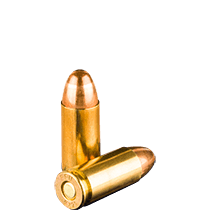
9x21mm IMI Ammo For Sale
Sorry but there is nothing in this category
Email me when the product is back in stock
Overview of 9x21mm IMI Ammo
Introduced in 1980, the 9x21mm IMI was a creation between the Franco Benvenuti agency of Italy and Israel Military Industries (IMI). Many countries, including Italy and most of the European Union, have banned the use of all military ammunition, such as the 9mm Parabellum. In order to circumvent gun control measures, the collaborative effort to create a substitute ammunition was seen as a good resolution and would allow civilians to own and use a powerful cartridge without fear of repercussions.
IMI managed to devise a cartridge that gave shooters the advantages of 9x19mm ammo without violating existing gun control measures. They made the cartridge two millimeters longer and created a new non-military cartridge. The case is longer, but the bullet seats deeper in the longer case – making the new 9x21mm the same length overall as the 9mm Luger cartridge. The biggest advantage is that firearms already chambered for the 9x19 did not require any major modifications. Instead, a simple swap of the barrel was all that was needed to allow for the different length of the case.
Specifications
A typical 9x21mm IMI cartridge fires a 115 or 123 grain full metal jacket bullet at a muzzle velocity of 1,100 to 1,200 feet per second, producing similar external ballistics to 9x19mm loads. As it is a rimless round, the 9x21mm is used in USPSA/IPSC competition in Open Class firearms. A rimless case is preferred because, unlike rimmed cartridges, it will not tend to lock together with other rounds in a double-column magazine, resulting in a malfunction. As other .38 Super–based rimless cartridges became available, the 9x21mm decreased in popularity in the United States for competition use, but it is still widely used in the rest of the world.
9x21 ammunition enjoyed another advantage upon its release – the United States Practical Shooting Association (USPSA) didn't permit the use of 9mm Luger as a Major Power Factor cartridge, due to the generation of unsafe pressures. The 9x21mm achieved Major Power Factor velocities without the dangerous consequences of the 9mm Luger handguns of the time.
Muzzle energy of 400 foot pounds, muzzle velocity of 1,250 feet per second with a 123 grain FMJ bullet, and a velocity of 1,300 feet per second with a 115 grain bullet is what you can expect from the 9x21mm. But the cartridge lost many U.S. shooters when the .38 Super arrived on the scene, and the USPSA allowed 9x19mm to reach Major Power Factor in open division pistol competitions.
The 9x21 is popular still in Europe – especially among those who shoot competitively. Glock, as well as many other manufacturers, continue to produce handguns in this caliber with no signs of demand dropping in the near future.
9x21mm IMI Ballistics: Chart of Average 9x21mm IMI Ballistics
Note: This information comes from the manufacturer and is for informational purposes only. The actual ballistics obtained with your firearm can vary considerably from the advertised ballistics. Also, ballistics can vary from lot to lot with the same brand and type load.
| 9x21mm IMI Bullet WEIGHT | Muzzle VELOCITY (fps) | Muzzle ENERGY (ft. lbs.) | Mid-Range TRAJECTORY (in.) | Barrel Length (in.) | |||||
|---|---|---|---|---|---|---|---|---|---|
| Muzzle | 50 yds. | 100 yds. | Muzzle | 50 yds. | 100 yds. | 50 yds. | 100 yds. | ||
| 123 Grain | 1220 | 1095 | 1010 | 409 | 330 | 281 | -3.15 | n/a | 5" |
| 124 Grain | 1150 | 1050 | 980 | 365 | 305 | 265 | -3.15 | n/a | 5" |
